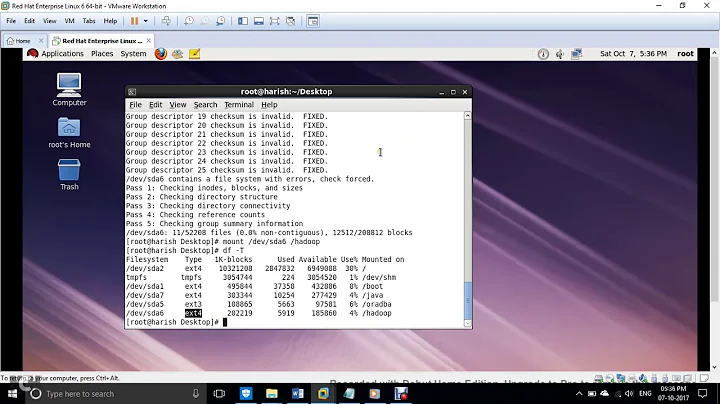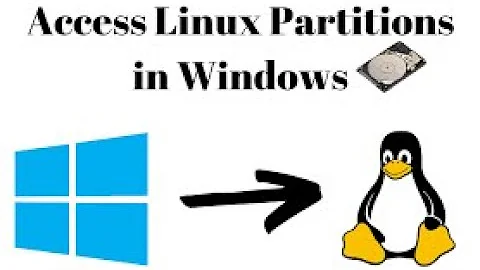How do I know if a partition is ext2, ext3, or ext4?
Solution 1
How do I tell what sort of data (what data format) is in a file?
→ Use the file utility.
Here, you want to know the format of data in a device file, so you need to pass the -s flag to tell file not just to say that it's a device file but look at the content. Sometimes you'll need the -L flag as well, if the device file name is a symbolic link. You'll see output like this:
# file -sL /dev/sd*
/dev/sda1: Linux rev 1.0 ext4 filesystem data, UUID=63fa0104-4aab-4dc8-a50d-e2c1bf0fb188 (extents) (large files) (huge files)
/dev/sdb1: Linux rev 1.0 ext2 filesystem data, UUID=b3c82023-78e1-4ad4-b6e0-62355b272166
/dev/sdb2: Linux/i386 swap file (new style), version 1 (4K pages), size 4194303 pages, no label, UUID=3f64308c-19db-4da5-a9a0-db4d7defb80f
Given this sample output, the first disk has one partition and the second disk has two partitions. /dev/sda1 is an ext4 filesystem, /dev/sdb1 is an ext2 filesystem, and /dev/sdb2 is some swap space (about 4GB).
You must run this command as root, because ordinary users may not read disk partitions directly: if needed, add sudo in front.
Solution 2
Another option is to use blkid:
$ blkid /dev/sda1
/dev/sda1: UUID="625fa1fa-2785-4abc-a15a-bfcc498139d1" TYPE="ext2"
This recognizes most filesystem types and stuff like encrypted partitions.
You can also search for partitions with a given type:
# blkid -t TYPE=ext2
/dev/sda1: UUID="625fa1fa-2785-4abc-a15a-bfcc498139d1" TYPE="ext2"
/dev/sdb1: UUID="b80153f4-92a1-473f-b7f6-80e601ae21ac" TYPE="ext2"
Solution 3
You can use sudo parted -l
[shredder12]$ sudo parted -l
Model: ATA WDC WD1600BEVT-7 (scsi)
Disk /dev/sda: 160GB
Sector size (logical/physical): 512B/512B
Partition Table: msdos
Number Start End Size Type File system Flags
1 32.3kB 8587MB 8587MB primary ext3 boot
4 8587MB 40.0GB 31.4GB primary ext4
2 40.0GB 55.0GB 15.0GB primary ext4
3 55.0GB 160GB 105GB extended
5 55.0GB 158GB 103GB logical ext4
6 158GB 160GB 1999MB logical linux-swap(v1)
Solution 4
Surprised this isn't on here already.
No sudo required:
lsblk -f
Solution 5
Still another way, since you know you're running some flavor of ext?, is to look at the filesystem's feature list:
# tune2fs -l /dev/sda1 | grep features
If in the list you see:
-
extent— it's ext4 - no
extent, buthas_journal— it's ext3 - neither
extentnorhas_journal— it's ext2
The parted and blkid answers are better if you want these heuristics run for you automatically. (They tell the difference with feature checks, too.) They can also identify non-ext? filesystems.
This method has the virtue of showing you the low-level differences.
The important thing to realize here is that these three filesystems are forwards compatible, and to some extent backwards-compatible, too. Later versions just add features on top of the older ones.
See the ext4 HOWTO for more information on this.
Related videos on Youtube
user2935706
Updated on September 18, 2022Comments
-
user2935706 over 1 year
I just formatted stuff. One disk I format as ext2. The other I want to format as ext4. I want to test how they perform.
Now, how do I know the kind of file system in a partition?
-
zacharyalexstern over 11 yearsOut of curiosity, what are you trying to test? Journal vs. no journal? For the record, you can operate ext4 in no-journal mode, and still benefit from all the other new features.
-
 Ciro Santilli Путлер Капут 六四事 over 8 years
Ciro Santilli Путлер Капут 六四事 over 8 years
-
-
user2935706 over 11 yearsparted is not installed. Also the drives are not mounted yet.
-
 tonybka over 11 years@JimThio I assume you were able to install it? You should be able to get it by simply doing
tonybka over 11 years@JimThio I assume you were able to install it? You should be able to get it by simply doingsudo apt-get install parted(orgparted) if you are on Ubuntu or any other debian derivative. -
Warren Young over 11 yearsThis has the same weakness as h3rmiller's
mountbased answer. -
Warren Young over 11 years+1: I've verified that this gives the correct result when mounting an
ext2filesystem withmount -t ext4.blkidisn't fooled by that. -
Warren Young over 11 years+1: I've verified that this gives the correct result when mounting an
ext2filesystem withmount -t ext4.partedisn't fooled by that. -
Warren Young over 11 yearsh3rrmiller removed his answer, so for those who don't have the rep to see it now, the problem is that if you say
mount -t ext4on anext2filesystem,df -Treportsext4. That is, it's just reading what the mount table says, not looking at the filesystem metadata to figure this out. -
mattdm over 11 years@Warren: That's because it is an ext4 filesystem in that case. Just one with not many features.
-
Warren Young over 11 years@mattdm: So when you unmount it...is it still an ext4 filesystem?
-
mattdm over 11 years@Warren: in a sense, all ext2 filesystems are also ext4 filesystems, yes. (But of course, not in the sense most people mean.)
-
Warren Young over 11 yearsOn what system?
fdisk, on the system I'm using at the moment at least, only shows the partition type, not the filesystem type. That means not only can't it tell the difference betweenext2,ext3, andext4, it also can't discern ReiserFS or XFS from these. -
user2935706 over 11 yearsWhile this is not the most upvoted answer, this is the one I actually use. Also I do not need to specify the device.
-
user2935706 over 11 years+1 for effort. I have done fdisk before asking this question. Keep points up.
-
heinrich5991 over 11 yearsWhen entering
$ sudo file /dev/sda1, I get/dev/sda1: block special -
Warren Young over 11 yearsIn that case, I've been using
ext4since 1993 or so, in Yggdrasil Linux. I'm probably usingext5already. Woohoo, I live in the FUTURE! -
Cannon8668 over 9 yearsdoesn't work for LVM stuff: parted -l seems to work better
-
 Gilles 'SO- stop being evil' over 9 years@TiloBunt It works for LVM as well. The device name will be
Gilles 'SO- stop being evil' over 9 years@TiloBunt It works for LVM as well. The device name will be/dev/VOLUMEGROUP/LOGICALVOLUMEor/dev/mapper/VOLUMEGROUP-LOGICALVOLUMEinstead of/dev/sdLETTERDIGIT. -
 Gilles 'SO- stop being evil' over 9 years@TiloBunt Make that
Gilles 'SO- stop being evil' over 9 years@TiloBunt Make thatfile -sL /dev/mapper/foo-bar, with the-Lflag to dereference the symlink. -
 Jose Diaz-Gonzalez about 9 yearsFor what its worth, this also appears to work for xfs drives, though apparently it's
Jose Diaz-Gonzalez about 9 yearsFor what its worth, this also appears to work for xfs drives, though apparently it'sblkidis not as great aslsblkis at detecting unmounted drives (if you need to) -
 iTag almost 9 yearsIf I run this without
iTag almost 9 yearsIf I run this withoutsudotheFSTYPEcolumn is blank. -
 Freedom_Ben almost 9 years@Flup I just tried it myself again and it worked perfectly without sudo. FSTYPE column was fully populated. May be some disparity between our systems?
Freedom_Ben almost 9 years@Flup I just tried it myself again and it worked perfectly without sudo. FSTYPE column was fully populated. May be some disparity between our systems? -
don_crissti over 8 years@Flup - you must be using Debian/Ubuntu or derivatives... They're famous for doing something (or maybe not doing something, I wouldn't know) and the end result is you need root privileges to list some
lsblkcolumns... -
 Basile Starynkevitch over 8 yearsBecause it is not the best answer: a partition might be grub-labeled as ext2 and contains ext4 filesystem (and then would be mounted as ext4 with
Basile Starynkevitch over 8 yearsBecause it is not the best answer: a partition might be grub-labeled as ext2 and contains ext4 filesystem (and then would be mounted as ext4 withmount -t auto) -
Brain2000 about 8 yearsThanks! The file command wasn't working, but this gave me what I needed.
-
rectalogic almost 7 yearsI've been using this technique for years. But today it failed because the unformatted EBS volume happens to match the signature of a DOS executable:
$ sudo file -s /dev/xvdm /dev/xvdm: DOS executable (COM) -
 Gilles 'SO- stop being evil' almost 7 years@rectalogic
Gilles 'SO- stop being evil' almost 7 years@rectalogicfileguesses, and sometimes it can guess wrong. When you know what kind of file you're looking at (e.g. you know that it's a filesystem image) it works reasonably well. When it's open-ended, such as in your case with a volume that contained “random” garbage, there can be false positives. COM executables don't actually have any structure, so therefilehas both many false positives and many false negatives. -
rectalogic almost 7 yearsI've switched to using
blkid -o value -s TYPE /dev/xvdm- it exits with 2 if the device is unformatted, otherwise prints the filesystem, and works with LUKS encrypted filesystems. -
jokab over 5 yearsi had to sudo blkid /dev/sda1 else I get blank results
-
zer09 over 4 yearsBest answer for me, using without sudo, also works on Debian/Ubuntu derivatives, I am on Pop Os.
-
Vishnu Dasu over 2 years




